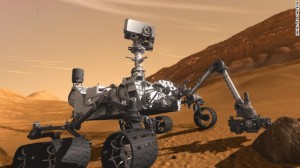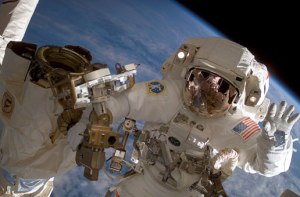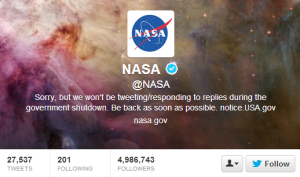Democracy depends on participation. Participation depends on transparency. Transparency depends on sharing information. That’s where social media comes in.
Tools like Facebook, Twitter, Instagram are increasing the information you have access to. And public agencies are using these tools as ways to gain and keep public trust by providing that information: early, often and in ways that give you as direct of an experience as possible.
NASA is one of the top government agencies giving you a behind the scenes look at their work and providing you outlets to get involved.
Last year NASA was named the 8th most engaged brand on Twitter. It also won back-to-back Shorty Awards for best government use of social media. Ever since their launch into social media in 2008 with their @MarsPhoenix Twitter account, NASA has proven that they know how to navigate cyber space just as well as outer space. Today, @NASA on Twitter has 6.19 million followers and growing, the most of any federal government agency.
One of the agency’s most engaging programs, NASA Social provides opportunities for active social media users to learn more about NASA’s missions, people and programs and share this information with their followers.
Earlier this month, we told you about NASA’s Social Media Accreditation program. Active social media users who earn these social media credentials gain unprecedented access to NASA Social events including space launches and their budget roll-out. They are treated the same as traditional media. This program aims to keep the standards of the 4th Estate in tact while gaining more exposure for the work of the agency in the realm of the 5th Estate. It also helps NASA to reach new audiences beyond those of it’s more than 450 different social media accounts.
This week we hear from John Yembrick, NASA’s social media manager. He tells us more about the NASA Socials program, how social media is creating new journalistic standards and shares NASA’s secret to social media success. We hope you enjoy his insights.
– – –
What inspired the NASA Social program?
Government agencies such as NASA can sometimes feel large, cold and walled off. The NASA Social program, formerly the NASA Tweetup program, began as a way to open our doors to the public and provide them with an inside, behind the scenes look at what their space agency is doing. In exchange, we hope that the NASA Social guests get inspired by what they’re seeing and communicate it to their friends and followers on social media.
Entry into a NASA Social is not randomly granted. Can you explain the criteria you used to select participants and why?
There are different types of NASA Social programs, and each has a different requirement. A traditional NASA Social simply asks that you be active on social media. In a sense, it’s not entirely random because we do review people’s accounts to ensure that they’re not only on social media, but that they actively post content. We also review posts to look for inappropriate content in posts that aren’t family friendly or are spam. That said, as long as someone is active on social media, they can be randomly chosen. We don’t pick favorites. We do allow for a few VIP slots for highly influential folks or people who may reach a different demographic. But overall, we don’t judge someone’s value based on the number of followers they have. We often have many first-time NASA Social participants who have small, yet active followings.
We also have a NASA Social Accreditation, which basically badges NASA Social guests the same as news media. For these Socials, we also try our best to mirror the experiences with social guests and journalists. For a Social Accreditation, it’s certainly not random. Folks fill out an application instead of a registration form and are evaluated against the stated criteria. We are generally looking for robustly active users who are followed by audiences that NASA doesn’t fully reach organically.
What other agencies do you think are breaking new ground in using social media?
Overall the Federal Government has made strides to improve the quality (and quantity) of information being shared via social media. A few examples of great things include the U.S. Department of Education’s #askFAFSA office hours that provide amazing customer service to student loan applicants. Also impressive is the U.S. Department of the Interior use of visual imagery to share America’s public lands via social media, especially Instagram. These are just two of many incredible examples of the federal government meeting the challenge of communicating with citizens using social media.
An important part of social media is personality, and “having personality” often means offering an opinion. What is the personality NASA is trying to project through its social media?
As an agency, we have over 450 total social media accounts, and with that come a variety of voices. But our overall goal is clean the windows so the public can get a clear view of what their space program is doing. To do this effectively, we aim to write creative posts with compelling images. The @MarsCuriosity account, for example, tweets in the first person, humanizing the rover and helping to make it more relatable. Is the rover tweeting? Of course not. It’s three brilliant women from NASA’s Jet Propulsion Laboratory in Pasadena, Calif. At the end of the day, we represent the agency, so it’s NASA’s work, messages and goals we try and communicate.
How do you balance your followers’ opinions with that of NASA?
NASA doesn’t project an opinion. We’re neutral in a sense. There are members of the public that don’t always agree with the direction of the agency, and many of them aren’t shy about telling us on social media. This, I believe, is a good thing. Before social media, there was very little way we could communicate directly with these people, but today we have a channel to respond to their questions and clear up mis-perceptions. You can’t always change people’s minds, but powerful content often has a way of slowly convincing people the value of space exploration and how it impacts their lives.
What is the most significant way you’ve seen social media change the news industry?
I’m a career government public affairs officer. I spent many years writing and distributing news releases, pitching stories and catering to news media. We had no choice. If the media didn’t report what we were doing, it’s likely no one would know. For an agency like NASA, that is literally making new discoveries daily about the universe and benefiting the world we live in, that’s a huge disservice to the public. I always understood that there’s only so much ink in a newspaper, but the digital world is here, so if you want to know about what NASA’s doing, we can open that door for you. The news industry no longer has to be the single source for information, and that’s made a significant difference to how we’re connecting with the public. We’re telling our own story.
It’s funny, we as an agency still spend a lot of time crafting news releases. That voice – “NASA announced today that…” – isn’t appropriate for social media. Many journalists get their information directly from social media. We see it happen all the time at NASA. Stories get reported that never had a news release associated with them.
In general, what journalistic standards should apply reporting via social media?
That’s a great question, because we often forget the importance of having standards when posting to social media. There are a few simple ones, such as referencing a source and being timely. Credibility matters for any brand, and there’s a lot of responsibility for us to post content in a professional manner. Therefore, we try and use AP Style when posting and not abbreviate unless absolutely necessary. We always avoid slang and poor grammar. Above all, accuracy matters. When we write a news release, 15 people may review it before it goes out. But with a tweet, it might be just one person at their computer. We try our best to ensure we fact check before we publish.
Has social media created any new standards?
We’ve worked to transform the way our public affairs officers think about how they do their jobs. Social media has to be thought of for every NASA discovery and news story. For example, news conferences used to be the standard way we broke big stories. But also, we have to write content in a way that is relatable to our followers. This includes using the right terminology. Internally, we’ll call it an extra vehicular activity or EVA – but everyone else will know it as a spacewalk. That’s important to know if we are to be effective communicators and social media has given us an instant feedback mechanism as our followers modify our tweets and posts to change the wording. It’s examples we can learn from all the time.
Of the 100 most followed Twitter accounts, last year’s Nestivity Study determined that NASA was one of the most engaged brands. What do you think sets NASA’s social media presence apart from the rest?
One word: content. Jason Townsend, my colleague and NASA’s Deputy Social Media Manager, and I are proud of the work we do to share space exploration with the world using social media, but at the end of the day, our job of engaging the public is easier than most. After all, we’re sharing stories that fundamentally change our understanding of the universe. We’re posting images of Earth from the International Space Station and of planets and distant galaxies. Who else can do that?
Social media is increasingly becoming a political force. Were you expecting the largely supportive reaction NASA received via social media during the government shutdown?
There are few things that make me as proud as when the community posted #ThingsNASAMightTweet during the government shutdown. Our community on social media, which is made up of many NASA Social alumni, is powerful when motivated. The level of support for NASA during the shutdown wasn’t random. It was based on people’s love and commitment for something that inspires them and influences their lives. When a NASA Social concludes, people return to their lives, and often go back to posting about things other than space exploration, and that’s okay. But we like to think we helped make a positive impact on their lives, and that was on display during the shutdown.
What can people look forward to from the NASA Social Program this year?
We’re constantly learning and evolving. There isn’t a day that goes by that Jason and I don’t see a way that we could do things differently and better. I suspect you’ll see us share and package our live programs a little differently to be more engaging. We want to have the NASA Social community at the table with us, asking questions and making suggestions. We want to transform the experience where the public goes from observing what NASA is doing to participating with us.
– – –
We look forward to following all of the great content NASA posts on its social media accounts. If you are an active social media user interested in applying for the NASA’s Social Media Accreditation Program click here for upcoming opportunities. For all the ways you can follow NASA on social media click here.
Liz Faris, Account Manager
Collaborative Services, Inc.






Recent Comments